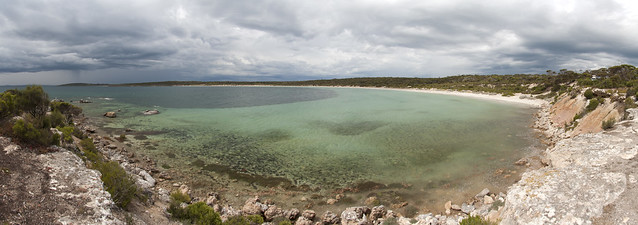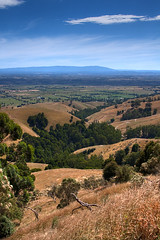A study in panorama
Friday, January 1st, 2021 at 02:44pm
Every couple of years I clean behind my desk. I don’t do it more often as this task involves taking everything off the desk, unplugging everything and disassembling the desk. Once clean I then have to put it all back together, all up this takes a number of hours so is generally done when I have time off around the new year.
Previously I have taken a photo of the tidy desk, but this time I attempted to capture most of the room in a panorama:
I spent about an hour just on taking the photos for this, camera on tripod, in portrait with my homemade L bracket, and using my widest lens. Each set is eight or nine images and I took around five sets until getting a set I was happy with. I initially considered capturing the full 360°, but that was more difficult to get aligned so I settled on around 280°, skipping the cupboard and room doors.
The above panorama was merged in Lightroom with the built in tool, but if you look at the large image you can quickly find a number of alignment issues. Look along shelves, picture frames, the cornice, etc. A proper panoramic tripod head would have helped, but I don’t have one of those.
I had a try at using Photoshop to do the merge, it essentially gives the same results but with each source image as a layer so you can fine tune where the joins are and then re-merge for exposure. At least that is what I picked up from reading some tutorials, I don’t know how to do that because I rarely use Photoshop.
Thinking back at how I have made panoramas in the past I realised that I wanted to be able to go to a misaligned part and be able to fine tune that section so they were aligned. Something like I remember doing in the Canon PhotoStitch software, but that was 20 years ago and while I do happen to have the install for that, it doesn’t want to run under Windows 10.
Another program that have used is the Microsoft Image Composite Editor which I recalled was an amazing tool, but it was last updated five years ago. I gave it a try anyway, no better than Lightroom and also no fine tuning ability.
It was getting late, so thought that the Lightroom merge was good enough so I uploaded it to Flickr and wasn’t going to spend anymore time on it. Until today when I decided to see what had happened to another tool I remembered: Hugin
Back in 2011 on a road trip from Melbourne to Perth and back I played around a fair bit with Hugin. What I remember of it was that it could give good results, but it was also prone to crashing. I don’t know when I last used it because I don’t do panoramas that often and the one in Lightroom has been good enough when I do make a panorama. Upon finding that it was still an active project and that it had a release only a few weeks ago meant that I had to give it a try:
I was impressed. While I saw the options to fine tune control points and other things, the above panorama was made using the simple settings and it has come out a lot better than Lightroom or Photoshop. All the big issues I saw before are fixed, with only a couple remaining on the lower right that could be fixed by a small amount of cloning.
However it is nowhere near as convenient as selecting the images in Lightroom and clicking Photo Merge > Panorama. Instead I exported full size versions as TIFF, loaded those into Hugin, generated the panorama, copied the result into the directory for Lightroom to see. I also took the final image into Photoshop for some content aware fill of floorboards in the corners and tweaked some levels before exporting the final JPEG for Flickr.
I don’t know if I will use Lightroom or Hugin for my next panorama, but it is good to know that suitable alternatives exist.













